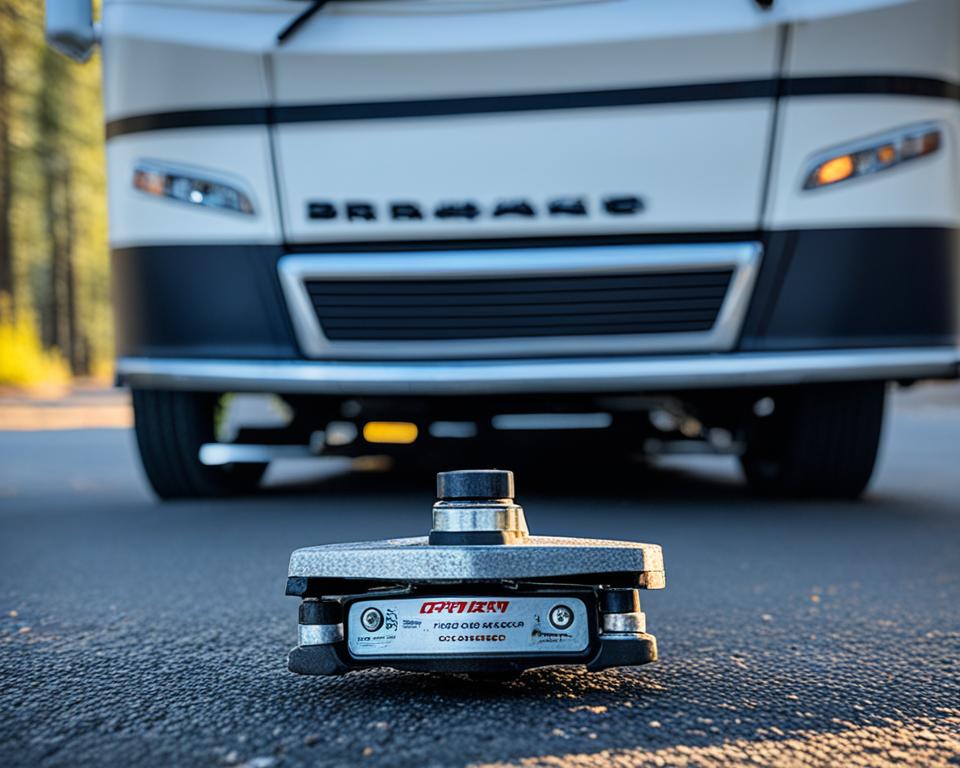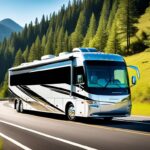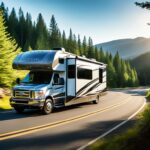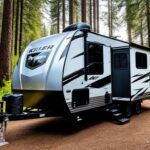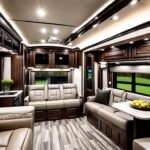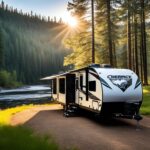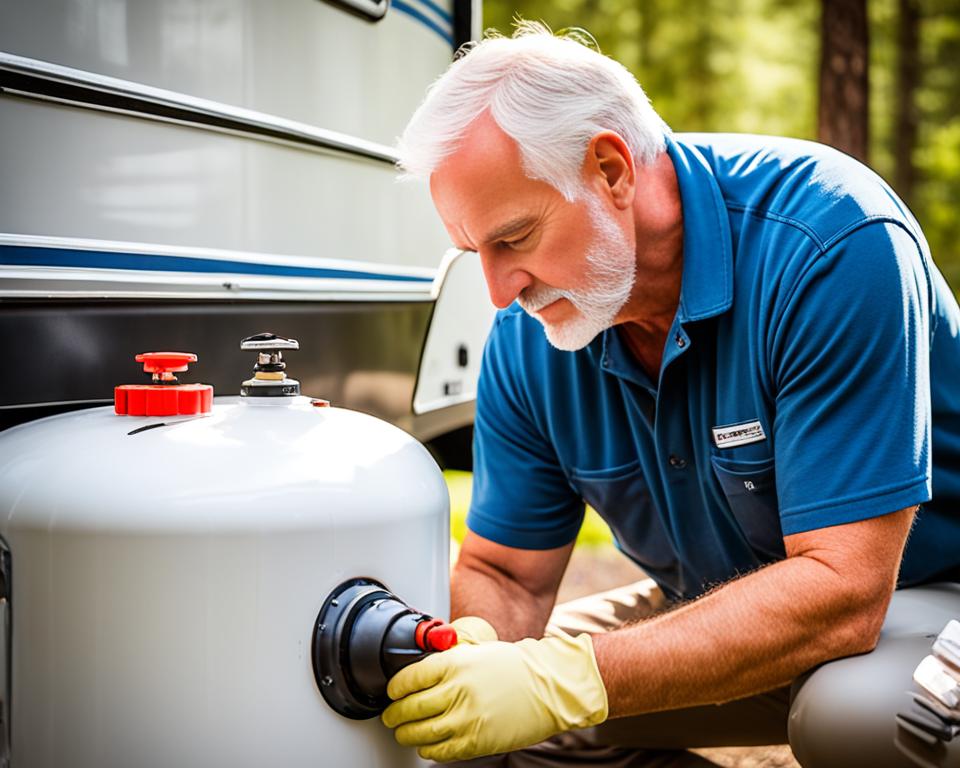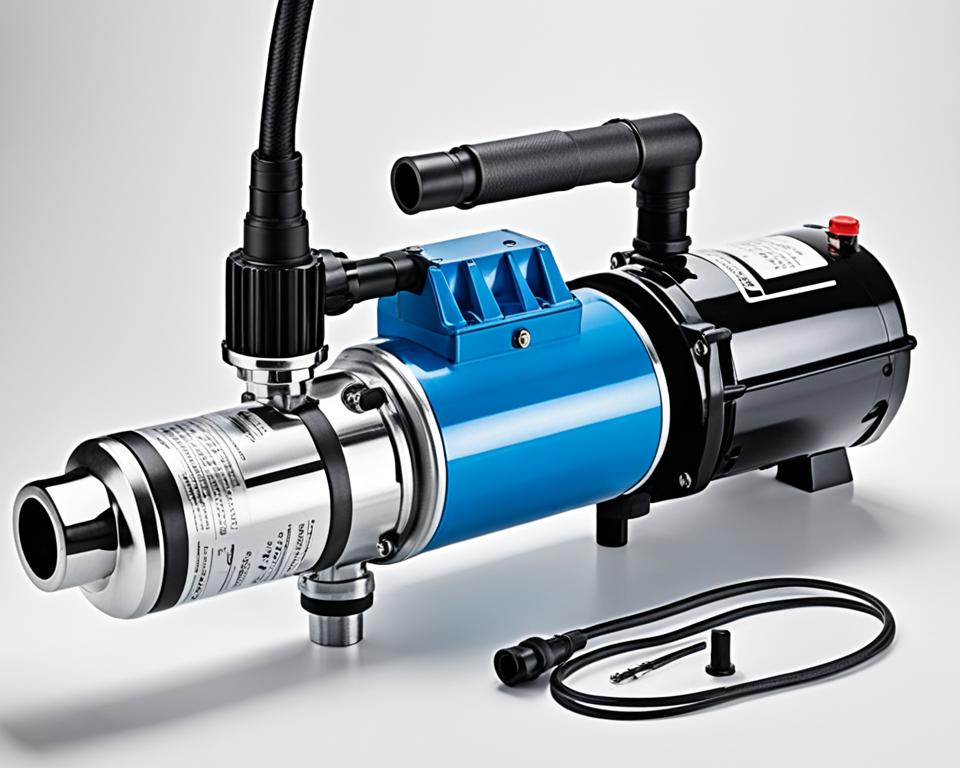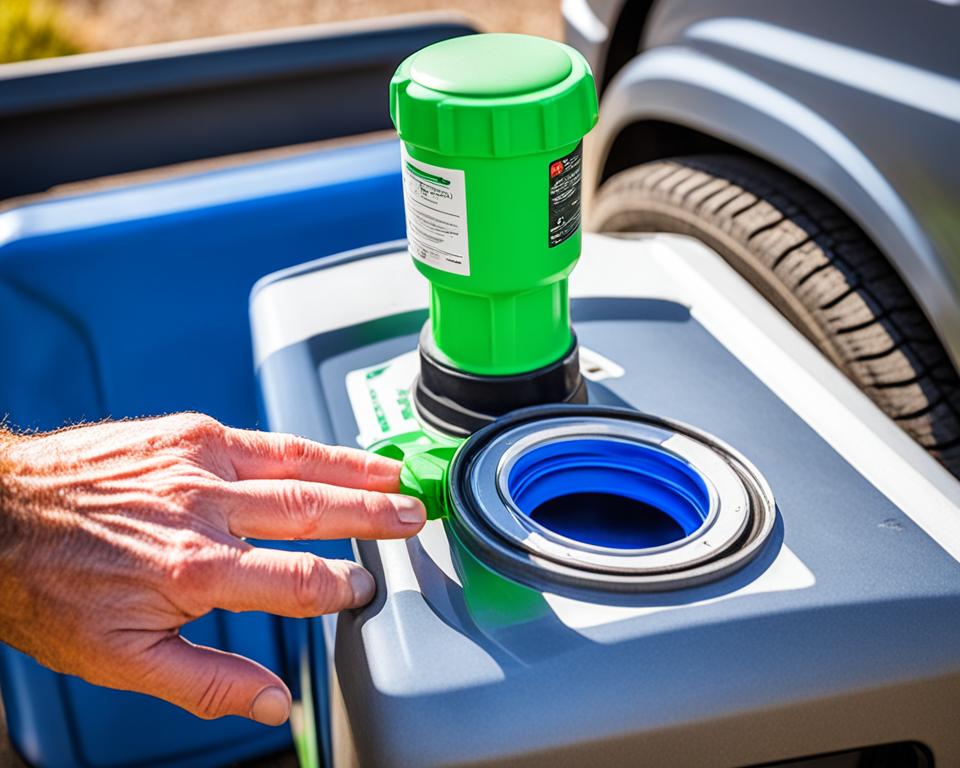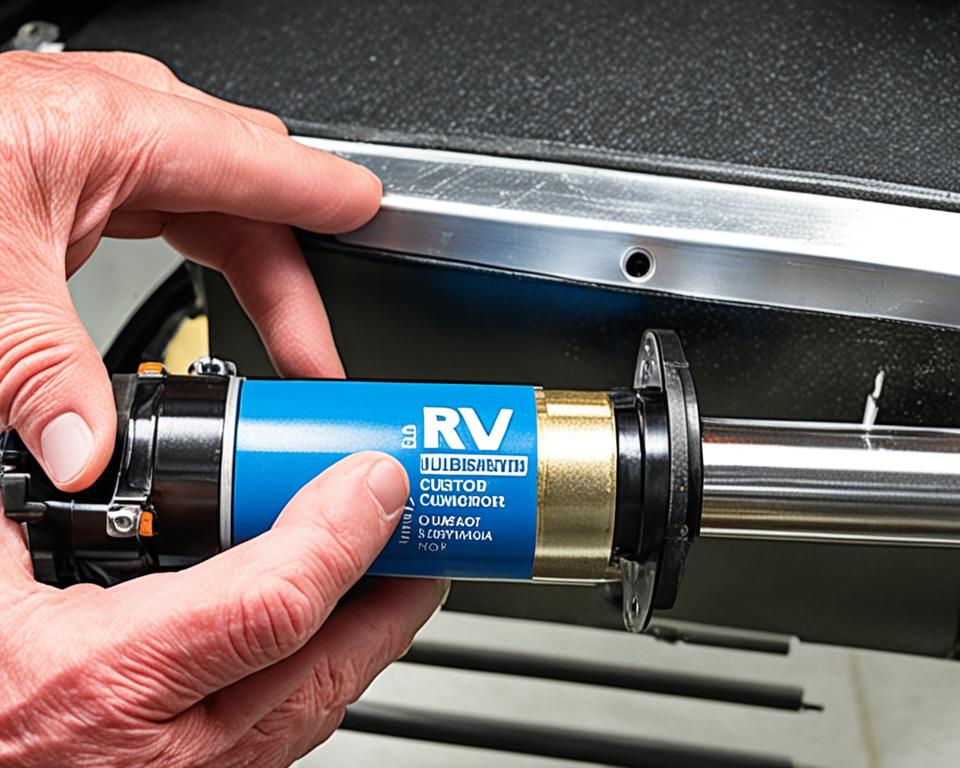One of the most important aspects of RV maintenance is routine brake system checks. Neglecting brake maintenance can have serious consequences, including compromising the safety of your RV and its occupants. In this comprehensive guide, we will explore the different types of RV brakes, provide essential maintenance tips, and offer guidance on using your RV brakes effectively and safely.
Key Takeaways:
- Regular brake system checks are vital for RV safety and performance.
- Understanding the different types of RV brakes helps with maintenance and troubleshooting.
- Proper maintenance includes inspecting, adjusting, and replacing brake components.
- Knowing how to use RV brakes correctly is essential for safe travels.
- Regular inspections and professional diagnostics aid in determining brake replacements.
Types of RV Brakes
RVs utilize different types of braking systems, each with its own components and diagnostic requirements. Understanding these various systems is crucial for proper maintenance and troubleshooting of your RV brakes.
Hydraulic Brakes
Hydraulic brakes are commonly found in modern RVs and operate using brake fluid to apply pressure to the brake pads or shoes. This system consists of several components, including:
- Master cylinder
- Brake lines
- Brake calipers or wheel cylinders
- Brake pads or shoes
Regular inspection and replacement of brake fluid is necessary to maintain the efficiency of hydraulic brakes. Diagnostic checks should include assessing the condition of the brake hoses, checking for leaks, and evaluating the overall braking performance.
Air Assist Brakes
Designed for larger motorhomes, air assist brakes provide increased stopping power. This system utilizes compressed air to engage the brakes, often in combination with hydraulic systems. Key components of air assist brakes include:
- Air compressor
- Air reservoir
- Brake lines
- Air brake chambers
Regular inspections of the air compressor and reservoir are necessary, along with checks for leaks and proper air pressure. Diagnostic evaluations should focus on the functionality of the air brake chambers and the overall braking performance.
Electric Trailer Brakes
Electric trailer brakes are commonly used in travel trailers and fifth wheels, activated through a connection to the tow vehicle. The primary components of this system are:
- Brake magnets
- Brake shoes
- Brake drums
Regular adjustment of the brake controller is essential for optimal braking performance. Diagnostic checks should include inspecting the brake magnets, ensuring proper shoe-to-drum clearance, and evaluating the brake actuation.
Auxiliary Braking Systems
Auxiliary braking systems serve as additional braking mechanisms that can enhance the overall stopping power of an RV. These systems are particularly useful when towing heavy loads or in situations that require extra braking force. While there are different types of auxiliary braking systems available, they typically consist of:
- Actuator or controller
- Brake pedal simulator
- Brake actuation methods (such as vacuum, air, or electric)
Diagnostic checks for auxiliary braking systems should focus on the activation and synchronization of the system with the RV’s primary brakes.
To summarize, understanding the components and diagnostic requirements of different types of RV braking systems is essential for proper maintenance and troubleshooting. Regular inspections and evaluations ensure the safety and efficiency of your RV brakes.
| Brake System | Key Components | Diagnostic Requirements |
|---|---|---|
| Hydraulic Brakes | Master cylinder, brake lines, brake calipers or wheel cylinders, brake pads or shoes | Inspection of brake fluid, assessment of brake hoses, checking for leaks, evaluation of braking performance |
| Air Assist Brakes | Air compressor, air reservoir, brake lines, air brake chambers | Inspection of air compressor and reservoir, checks for leaks, evaluation of air brake chamber functionality and braking performance |
| Electric Trailer Brakes | Brake magnets, brake shoes, brake drums | Adjustment of brake controller, inspection of brake magnets, ensuring proper shoe-to-drum clearance, evaluation of brake actuation |
| Auxiliary Braking Systems | Actuator or controller, brake pedal simulator, brake actuation methods | Activation and synchronization of the system with the primary brakes |
RV Brakes Maintenance
Proper maintenance is crucial for ensuring the optimal performance and longevity of your RV brakes. The specific maintenance tasks will vary depending on the type of brake system installed in your RV. Regular inspection and replacement of brake pads and rotors may be necessary for disc brakes, while drum brakes require checks for deep grooves, hard spots, and worn brake shoes. Hydraulic brake systems need regular replacement of brake fluid to prevent moisture buildup, and air brake systems require draining the air reservoir and replacing the filter. Additionally, electric trailer brakes may need adjustment of the brake controller.
By prioritizing regular maintenance and addressing repairs in a timely manner, you can preserve the safety and effectiveness of your RV brakes.
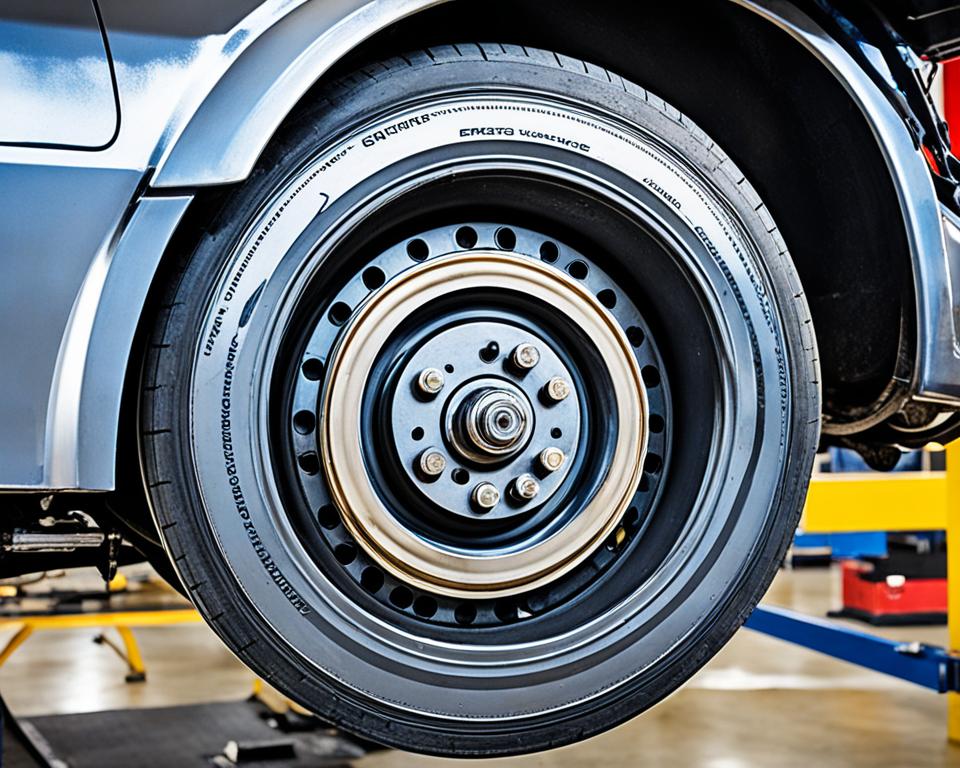
Regular maintenance is crucial for preserving the safety and effectiveness of your RV brakes.
Brake Maintenance Tips for Different Types of RV Brakes:
- Disc Brakes: Regularly inspect and replace brake pads and rotors when necessary.
- Drum Brakes: Check for deep grooves, hard spots, and worn brake shoes.
- Hydraulic Brake Systems: Regularly replace brake fluid to prevent moisture buildup.
- Air Brake Systems: Drain the air reservoir and replace the filter as needed.
- Electric Trailer Brakes: Adjust the brake controller for optimal performance.
By following these maintenance tips and addressing any issues promptly, you can ensure the safety and reliability of your RV braking system, providing peace of mind during your travels.
Remember, a well-maintained brake system is essential for safe and enjoyable RV adventures.
Using Your RV Brakes
Knowing how to properly use your RV brakes is as important as maintaining them. It is crucial to leave ample space between your RV and the vehicle in front of you, as RVs require longer stopping distances. Gradual and controlled braking is recommended to reduce wear on the brake components. Understanding when to engage auxiliary braking systems, if equipped, can further enhance your braking performance. Paying attention to any unusual noises or vibrations while braking and addressing them promptly is essential for safe travels.
When operating an RV, it’s vital to remember that the weight and size of these vehicles necessitate a different approach to braking. RVs require longer distances to come to a complete stop, so it’s crucial to maintain a safe following distance between your vehicle and the one ahead. This extra space allows for a smoother and safer braking process.
Additionally, practicing gradual and controlled braking can help preserve the integrity of your RV’s brake system. Rather than abruptly slamming on the brakes, gradually apply pressure to the pedal to slow down. This technique minimizes strain on the brake components and decreases the likelihood of premature wear.
If your RV is equipped with auxiliary braking systems, take advantage of their capabilities. These systems provide additional stopping power and can improve overall brake performance. Familiarize yourself with their operation and engage them when necessary, such as when driving on steep or winding roads.
“To ensure safe travels, it’s crucial to promptly address any unusual noises or vibrations experienced while braking. These may indicate underlying issues that require attention from a professional.”
How Often Do You Need New RV Brakes?
Determining the frequency of replacing RV brakes can be challenging, as it depends on various factors that influence wear and tear. Factors such as miles driven, road conditions, weight of the RV, type of brakes, and driving habits all play a role in determining the lifespan of RV brakes.
Regular inspections, troubleshooting, and diagnostic checks are essential in identifying when brakes need to be replaced. It is recommended to inspect the brakes every time before heading out on the road to ensure they are in optimal condition. Additionally, scheduling professional inspections at least once a year is advisable to detect any underlying issues and address them promptly. Keeping accurate records of your RV’s mileage and maintenance history also aids in determining when brake replacements are necessary.
To help you better understand when it’s time to replace your RV brakes, refer to the following table:
| Risk Factors | Replacement Frequency |
|---|---|
| Moderate miles driven, mostly on well-maintained roads | Every 20,000-30,000 miles or 3-5 years |
| Heavy usage, frequent towing, or mountainous terrain | Every 10,000-20,000 miles or 2-4 years |
| Poor road conditions, extensive off-roading, or excessive weight | Every 5,000-10,000 miles or 1-2 years |
Remember, your RV’s braking system is a critical safety component. Regular inspections, troubleshooting, and diagnostic checks will not only help keep you safe on the road but also extend the lifespan of your RV brakes.
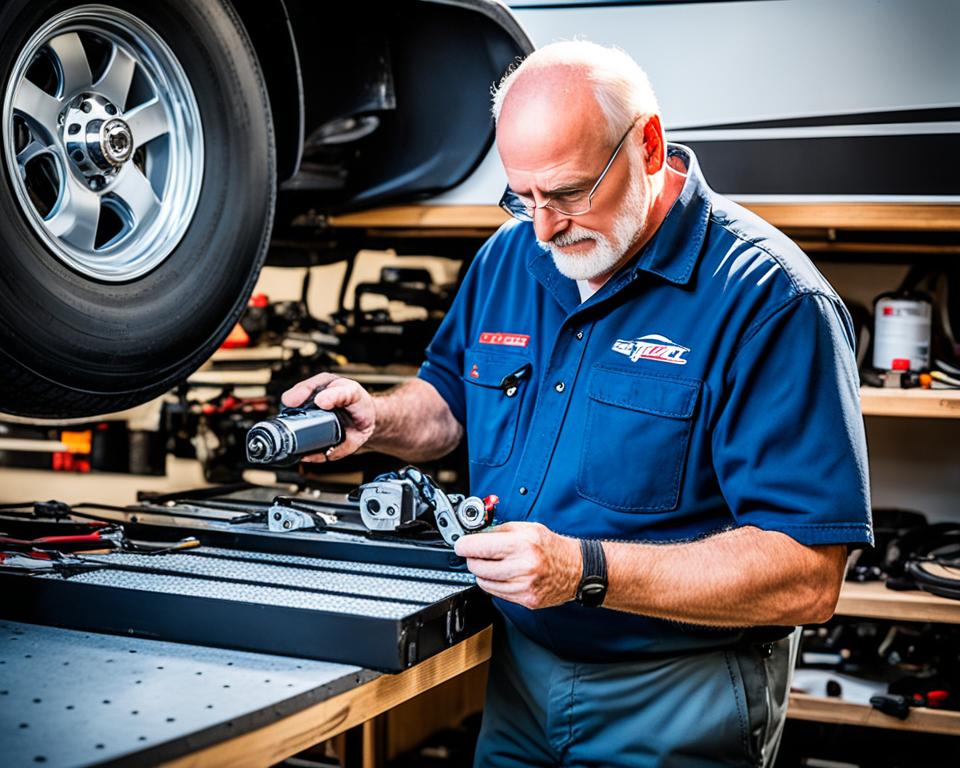
Troubleshooting Common Brake Issues
While regular inspections are important, it’s also essential to address any brake issues as soon as they arise. Here are some common brake problems and troubleshooting tips:
- Noise during braking: If you hear grinding or squeaking noises while braking, it may indicate worn brake pads or rotors. Have them inspected and replaced if necessary.
- Pulling to one side: If your RV pulls to one side when braking, it could be a sign of uneven brake pad wear or a stuck caliper. Check for any uneven wear and have it rectified promptly.
- Pulsation or vibration in the brake pedal: A warped rotor can cause pulsation or vibration in the brake pedal. If you experience this, it’s recommended to have the rotor resurfaced or replaced.
- Increased pedal depression: If you notice that the brake pedal requires more force or depresses further than usual, it could indicate a brake fluid leak or air in the brake lines. Have the brake system inspected to identify and resolve the issue.
By promptly addressing these common brake issues, you can ensure the optimal performance and safety of your RV’s braking system.
Signs Your Brakes Need Replacing
If you notice any of the following signs while braking in your RV, it may be an indication that your brakes need to be replaced:
- Noise during braking: Unusual noises, such as grinding or squeaking, can indicate worn brake pads or rotors. These noises can be a clear signal that it is time to replace your RV brakes.
- Pulling to one side: If your RV pulls to one side while braking, it could be a sign of uneven brake pad wear. This can occur when one brake pad is wearing down faster than the others, causing an imbalance.
- Pulsation or vibration in the brake pedal: Pulsation or vibration in the brake pedal may suggest a warped rotor. When the rotor is not perfectly flat, it can cause the brake pedal to pulsate or vibrate when pressure is applied.
- Increased pedal depression when applying brakes: If you find that you need to depress the brake pedal further than usual to achieve the same level of braking, it may be an indication that your brake pads have worn down and need to be replaced.
These signs should not be ignored, as they can compromise the effectiveness of your RV brake system and pose a safety risk. If you experience any of these signs, it is strongly recommended to have your brakes inspected and replaced if necessary.
“Maintaining a well-functioning brake system in your RV is crucial for a safe and enjoyable travel experience. Identifying the signs that your brakes need replacing and taking prompt action can help ensure that your RV’s braking system is always operating at its best.”
| Signs Your Brakes Need Replacing | What It Indicates |
|---|---|
| Noise during braking | Worn brake pads or rotors |
| Pulling to one side | Uneven brake pad wear |
| Pulsation or vibration in the brake pedal | Warped rotor |
| Increased pedal depression when applying brakes | Worn brake pads |
How to Check Your Brakes
Regularly checking your RV brakes is crucial for maintaining their performance and ensuring the safety of your RV. By conducting thorough inspections and functional checks, you can identify and address any issues promptly. The following are the key areas to focus on when checking your RV brakes:
- Motorhome Brakes Inspection:
Inspect the following components:
- Rotors
- Brake pads
- Drums
- Linings
- Hydraulic Brake System Inspection:
Check the following:
- Master cylinder
- Brake fluid levels
- Towable RV Brake Inspection:
Inspect and perform the following tasks:
- Shoe linings
- Brake spacing adjustment
- Brake controller functionality
Regular visual inspections and functional checks will help you identify any potential brake issues or signs of wear and tear. Addressing these issues promptly will ensure the safety of your RV brake system.
Remember to consult your RV’s owner’s manual for specific instructions and recommended maintenance schedules for your particular make and model. If you’re unsure about any aspect of brake inspection or maintenance, seek professional assistance from a certified RV technician.
“Regular inspections and functional checks will help you identify any potential brake issues or signs of wear and tear.”
By proactively checking your RV brakes, you can maintain their performance, prolong their lifespan, and ensure a safe and worry-free travel experience.
How Much Can You Tow Without Trailer Brakes?
The requirement for trailer brakes depends on the weight of the trailer and individual state regulations. While small trailers under 1,000 pounds may not require brakes in some states, most towable RVs are equipped with brakes for safety reasons. It is highly recommended to have trailer brakes, especially when towing larger and heavier RVs. Having trailer brakes provides the needed stopping power and helps maintain control while towing. It is important to comply with federal and state regulations to ensure the safety of yourself and others on the road.
| Trailer Weight | Brake Requirement |
|---|---|
| Under 1,000 pounds | Check state regulations |
| 1,000 – 3,000 pounds | Brakes recommended |
| 3,001 – 5,000 pounds | Brakes required |
| Above 5,000 pounds | Brakes mandatory |
Track Your RV Brake Maintenance
Keeping track of your RV brake maintenance is crucial for staying on top of necessary inspections and repairs. By utilizing online tools such as the RV LIFE Maintenance tool, you can maintain a comprehensive record of your RV’s brake maintenance history.
The RV LIFE Maintenance tool provides reminders for maintenance tasks and allows you to track mileage, inspections, and repairs. It offers a user-friendly interface where you can log details about each maintenance work, including the date it was performed, the specific components checked or replaced, and any additional notes or observations.
With this convenient tool, you can easily refer back to previous maintenance records to review which tasks were completed and when they were last performed. It helps you plan and schedule future inspections and maintenance, ensuring that no important brake services are overlooked or delayed.
By staying organized and proactive with your RV brake maintenance, you can ensure the safety and reliability of your RV braking system, giving you added peace of mind while on the road.
Conclusion
Routine RV brake system checks are imperative for maintaining the safety and performance of your RV. Regular maintenance, including inspections, adjustments, and replacements, is essential for optimal brake function. By staying proactive and following the maintenance tips and guidelines provided in this guide, you can enhance the longevity of your RV brakes and travel with peace of mind on the road.
Understanding the different types of RV brakes is key to effective maintenance. Whether your RV is equipped with hydraulic brakes, air assist brakes, electric trailer brakes, or auxiliary braking systems, it is important to know how to properly use them and recognize signs of wear and tear. Taking the time to inspect your RV brakes regularly helps identify any issues and address them promptly, ensuring the safety of your RV and its occupants.
Remember to leave ample space between your RV and the vehicle in front of you, as RVs require longer stopping distances. Gradual and controlled braking reduces wear on the brake components. Regularly checking the condition of brake pads, rotors, drums, and linings, as well as maintaining proper brake fluid levels, enables you to catch any potential problems before they become major safety concerns.
By prioritizing routine brake system checks and dedicating time to maintenance, you can enjoy a safe and enjoyable RV travel experience. With properly functioning brakes, you can navigate the roads with confidence and peace of mind, knowing that you have taken the necessary steps to ensure the safety and performance of your RV.
FAQ
Why are routine RV brake system checks important?
Routine RV brake system checks are important because they help ensure the safety of your RV and its occupants. Neglecting brake maintenance can lead to serious consequences and compromise the effectiveness of your brakes.
What are the different types of RV brakes?
There are several types of RV brakes, including hydraulic brakes, air assist brakes, electric trailer brakes, and auxiliary braking systems. Each type serves a specific purpose and requires different maintenance and troubleshooting techniques.
How do I properly maintain my RV brakes?
Proper maintenance of RV brakes includes regular inspection and replacement of brake pads, rotors, and shoes. Additionally, brake fluid should be replaced in hydraulic brake systems, air reservoirs should be drained and filters replaced in air assist brake systems, and brake controllers may need adjustment for electric trailer brakes.
What should I know about using my RV brakes effectively and safely?
It is important to leave ample space between your RV and the vehicle in front of you to account for longer stopping distances. Gradual and controlled braking is recommended to reduce wear and tear on your brakes. Understanding how and when to engage auxiliary braking systems, if equipped, can further enhance your braking performance.
How often should I replace my RV brakes?
The frequency of replacing RV brakes varies depending on factors such as mileage, road conditions, weight of the RV, type of brakes, and driving habits. Regular inspections, troubleshooting, and diagnostic checks can help determine when it’s time for a brake replacement. It is recommended to check brakes before every trip and schedule professional inspections at least once a year.
What are the signs that indicate my RV brakes may need replacing?
Signs that indicate your RV brakes may need replacing include noise during braking, pulling to one side, pulsation or vibration in the brake pedal, and increased pedal depression when applying brakes. Unusual noises, such as grinding or squeaking, could indicate worn brake pads or rotors. Pulling to one side may suggest uneven brake pad wear, and pulsation or vibration in the brake pedal may indicate a warped rotor.
How do I check my RV brakes?
Checking RV brakes involves inspecting various components such as rotors, brake pads, drums, linings, master cylinders, and brake fluid levels. Visual inspections and functional checks help identify any issues and ensure the safety and optimal performance of your RV brakes.
How much can I tow without trailer brakes?
The requirement for trailer brakes depends on the weight of the trailer and individual state regulations. While small trailers under 1,000 pounds may not require brakes in some states, it is highly recommended to have trailer brakes, especially when towing larger and heavier RVs, to ensure sufficient stopping power and maintain control while towing.
How can I track my RV brake maintenance?
Tracking your RV brake maintenance is important for staying organized and proactive. Utilize online tools like the RV LIFE Maintenance tool to maintain a comprehensive record of your RV’s brake maintenance history. These tools provide reminders for maintenance tasks and allow you to track mileage, inspections, and repairs.

